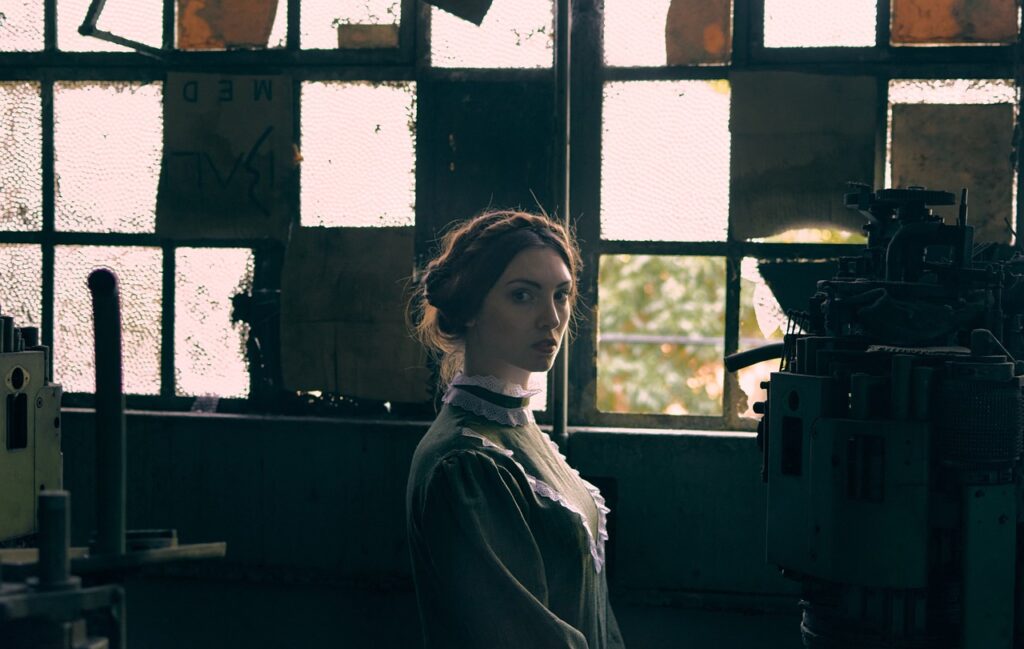France traditional clothing is renowned for being chic, refined, and timeless. The beret, a flat, round cap worn by men and women, is the most iconic item of France’s traditional clothing.
The Breton shirt, which is styled in stripes with a boat neck, and the Basque dress, a fitting dress with a high neckline and a voluminous skirt, are two further popular examples of French’s traditional clothing.
Popular is also the “Gallic” design, which is defined by fitted jackets, wide-legged pants, and berets. France traditional clothing typically features muted colors with simple designs and is highly conservative.
10 Types of France’s Traditional Clothing

1. The Beret.
Undoubtedly the most iconic item of France traditional clothing is the beret. It is a flat, circular cap that is frequently donned, tilted to one side, and is typically made of wool or felt.
It is considered to have its roots in the French Pyrenees region, and the working class was responsible for its initial popularization.
It subsequently evolved into a stylish item and is now seen as an embodiment of French culture. The black beret is the most well-known of the many colors that the beret comes in.
It is still popular among French citizens today and is regarded as an indispensable part of the French style.
The beret has contributed to France’s politics and history in addition to being a fashion accessory.
It became a symbol of resistance against the German occupation during World War II, courtesy of the French Resistance.
Former French President François Mitterrand also made headlines for donning it.
As a symbol of prestige and tradition, the beret is still worn by the French military and other institutions today. Even though it has changed over time, the beret has remained a classic and iconic symbol of French style and culture.
2. The Breton shirt
Brittany, a region in northwest France, is where the Breton shirt, a traditional piece of French clothing, was initially developed. The shirt often has a distinctive striped design and is woven from thick cotton.
The sleeves are typically rolled up, and it has a boat neck and an oversized fit.
It is thought to have started in the 19th century when Breton fishermen used it as a useful and utilitarian clothing. The shirt eventually developed popularity among the rich and famous and gained a reputation as a chic outfit.
When French painter Pablo Picasso began sporting a Breton shirt, it rapidly became fashionable.
Picasso and his fellow painters started wearing the shirt as a representation of their artistic sensibility because of its simplicity and timeless design.
French actress Brigitte Bardot made the Breton shirt popular in the 1950s, elevating it to a status symbol of elegance and style in France.
Celebrities and fashion luminaries from all over the world have sported the shirt in innumerable fashion shows. It is currently regarded as a timeless representation of French fashion.
3. The Basque dress
The “Pays Basque” style, commonly referred to as the “Basque dress,” is a customary outfit that has its roots in the Basque area of France and Spain. It is a fitting dress with long sleeves, a voluminous skirt, and a high neckline.
It usually has a lace-trimmed neck and is normally made from a colorfully striped fabric.
Since women in the area have worn the Basque dress for generations, it has grown to symbolize Basque identity and culture. It is frequently donned with a beret and is regarded as an enduring staple of clothing.
The Basque costume has evolved, yet it has stayed loyal to its historical origins. It has appeared in runway fashion shows and is frequently spotted on the Paris Fashion Week runways.
People with celebrity status and fashion influencers also like it because of its timeless, sophisticated appearance.
Although the Basque dress has historical roots, it has been further modified with contemporary forms and styles. The classic Basque dress, on the other hand, is still a cherished and recognizable fashion item thanks to its vivid colors and detailed design.
4. The Gallic style
The “Gallic” style, often called “la mode Parisienne,” is a France traditional clothing that has gained popularity since the beginning of the twentieth century.
The simplicity, expertise, and timeless nature of the style are its distinguishing features. The color scheme is neutral, and high-end fabrics like silk, wool, and cashmere are frequently used to create the clothing.
Gallic fashion, which takes its cues from the famous looks of Parisian ladies, is frequently regarded as stylish and relaxed. Its modest elegance distinguishes it, and people frequently refer to it as “the pinnacle of French style.”
With an emphasis on quality over quantity, the Gallic style is frequently viewed as a minimalist approach to clothing.
It has gained popularity due to French fashion businesses like Chanel and Hermès and is frequently paired with timeless items like the trench coat, the little black dress, and the perfect white shirt.
The 20th century produced some of the world’s most recognizable fashion designers, including Yves Saint Laurent and Coco Chanel, who were both famed for their distinctive Gallic designs.
It’s a look that women of all ages and socioeconomic levels have embraced, and it’s renowned for its understated yet sophisticated sense of style.

5. French maid costume.
A well-known attire frequently connected to French culture is the “costume de femme de ménage,” or French maid costume. An apron, a headgear, and a short black dress with white trim make up the usual costume.
The attire is usually donned by women for costume parties, cosplay, and roleplaying. Despite not being a piece of traditional clothing, it has gained popularity as a result of films, television series, and books. Additionally, the Moulin Rouge and burlesque performances are frequently linked to it.
There are currently numerous iterations of the French maid costume because it has evolved. One well-known variation is the “sexy French maid” costume, which includes a more exposed frock and accouterments like fishnet stockings and high heels.
Other varieties include the “rockabilly French maid” clothing, which is influenced by 1950s pin-up females, and the “steampunk French maid” costume, which has Victorian-style clothing.
No matter how it differs, the French maid outfit is frequently regarded as a representation of French charm and sensuality.
6. The Striped Sailor shirt.
Since the 1800s, the striped sailor shirt, or “marinière” as it is known in French, has been a staple of French fashion. The shirt was first worn by French sailors as a component of their maritime uniform before becoming popular among residents as a fashion accessory.
The shirt is normally composed of a cotton or wool fabric and has horizontal blue and white stripes. The “marinière” is often thought of as a representation of the French working class and marine culture.
Fashion leaders like Jean-Paul Gaultier and Coco Chanel have also helped to popularize it.
The “Breton stripe” is one of the striped sailor shirt’s most distinctive characteristics. This particular style of blue and white striped pattern was developed in Brittany, France. The “Breton stripe” can often be detected by the equal width of the stripes and the number of stripes employed (usually 21 or 22).
The “Breton stripe” has emerged as a major fashion trend, and numerous fashion designers have used it to produce a wide range of designs. The striped sailor shirt is an adaptable article of clothing that can be worn up or down and is suitable for both men and women to wear.
7. The petit blouson jacket.
A style of jacket called a “petit blouson” was invented in France in the 1950s. It is a short, form-fitting jacket with a classic nautical design.
The jacket frequently includes a zipper closure, cuffed sleeves, and a collar. It is normally in a neutral hue, such as navy blue or black, and often is made of a lightweight fabric like cotton or wool.
French fashion icon Christian Dior made the “petit blouson” famous in the 1950s, and it has since evolved into a staple of the nation’s wardrobe.
The “petit blouson” is a multipurpose jacket that can be dressed in many ways. Although it is frequently associated with informal wear, it can also be worn up for a more professional look. The jacket can be worn over a sweater or blouse and is often paired with jeans or pants. It is a well-liked option for travel because it is portable and light.
The “petit blouson” is regularly regarded as an essential part of traditional France clothing and is frequently connected to the nation’s “je ne sais quoi” disposition.
8. The Savate shoe.
The “savate” or “sabot” shoe is a traditional style of shoe that originated in France. The traditional shoe has a wooden sole with a leather top, a thick sole, and a rounded toe. The “savate” shoe was invented to protect the feet from very cold and damp weather conditions and was first worn by agricultural workers.
The “savate” shoe was modified for use in the sport of savate, a kind of French martial arts, in the 19th century. The “savate” shoe continues to be worn for martial arts in modern times, and it is also a well-liked fashion accessory.
The “savate” shoe is steeped in history and frequently referred to in French mythology. According to one folklore, the shoe was named after the “sabot,” a wooden shoe that was allegedly thrown into machinery by irate employees during the French Revolution.
According to another different narrative, the shoe got its name from the woodcutters, or sabotiers, who wore them to keep their feet safe from sawdust and other threats.
The “savate” shoe is frequently recognized in current society as a representation of France’s traditional clothing, culture, and pride. The shoe is frequently paired with vintage French clothing, such as Breton shirts and berets.
9. The Chapeau claque
The “chapeau claque” or collapsible hat is a distinctive style of hat that was first made in France in the 19th century. The hat can be folded into a compact, flat disc and is constructed from a frame of woven materials, including horsehair.
The upper classes were big fans of the hat because they had to carry their hats around and it was created to be portable.
Additionally, the “chapeau claque” was worn as fashion clothing, and it was frequently adorned with feathers, pearls, or other decorative elements.
Actors and actresses frequently wore the “chapeau claque” hat, which was strongly associated with the theater.
During a performance, the hat could be swiftly compressed and tucked under the actor’s attire, and it could be instantly inflated and put on when the actor went offstage.
The “chapeau claque” hat lost favor in the 20th century as other hat designs took its place. Fortunately, the hat has recently experienced a surge in popularity and is now regarded as a retro fashion accessory.
10. The Fichu
The “fichu” or “fichu de cou” is a style of scarf that was invented in France in the 18th century. The “fichu” is a very long, rectangular scarf that’s usually made of silk or other high-quality materials.
Numerous France traditional clothing can be worn with the scarf, which is wrapped into a triangle and draped around the neck. Initially, the “fichu” was made to conceal the décolletage, or low neckline, of dresses and robes.
Later on, though, it evolved into a trendy piece of clothing that could be worn by itself.
Conclusion
In conclusion, France’s traditional clothing is steeped in history and culture. Each piece of clothing has a distinctive history to share, from the recognizable “savate” shoe to the “fichu” scarf.
France traditional clothing has been worn by a wide variety of people throughout history and has come to represent France’s fashion and culture. These clothes are genuinely timeless, whether they are being worn as a fashion statement or as a tribute to the past.




